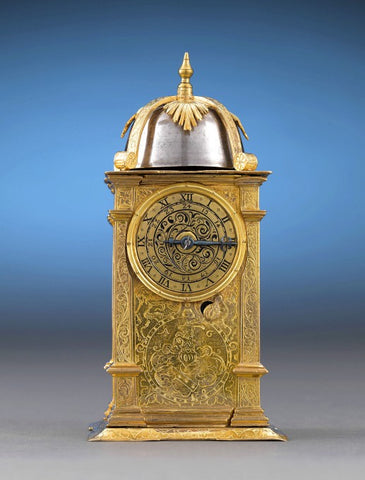|

|

|
Mention the Renaissance, and most people envision the revival of Classical literature and art after the dark days of the Medieval, or Middle Ages. But did you know that some of the world’s most important conveniences were invented during this period of cultural rebirth? The printing press, the match, and even the flush toilet are just a few of those pivotal creations that came out of Renaissance culture. One invention, however, not only filled a need in society, but also provided us with some of the most stunning mechanical works of art ever made…the clock. So, when were clocks invented exactly? Our experts are going to cover everything you need to know about the mechanical clock and how it became the modern timepiece we know today.
The mechanical renaissance clock is perhaps one of the most important inventions during this time period. Before this, time was kept via a sundial, which is actually quite accurate within a minute or so. Of course, the use of sundials are dependent upon the sun shining, making it impossible to tell time on overcast days or at night. In the Mid- and Far East, the water clocks were quite popular, and worked on a concept of water displacement, with a particular amount of displaced water indicating a specific amount of time. These early clocks eventually found their way to Europe, where they were used until the end of the 13th century. Though accurate, these elaborate timepiece mechanisms were often very cumbersome and required that an individual constantly monitor the timekeeping device day and night.
The Renaissance culture renewed interest in science and the arts and led to the eventual development of more practical, precise and beautiful timekeepers. The first known example that resembles what we think of as a clock set was built by a clockmaker in the town of Dunstable, in Bedfordshire, England in 1283. Known as a turret clock, these mechanisms were large, weight driven devices that were placed in tall building towers, or turrets, in the center of town. They lacked faces or hands, and simply struck the hours for all to hear.
|

|
Soon, the desire to make clocks smaller, more portable and user friendly spurred the creation of the spring-driven clock in the 1400s. This not only allowed timekeeping to be brought in the home, but it also gave artisans the chance to showcase their technical and artistic talents in these increasingly luxurious mechanisms.
This incredible Renaissance Turret (Table) Clock displays impeccable artistry inside and out. It’s firegilt brass case is enveloped in exquisite engravings paying homage to the Liberal Arts, while the gut/fuseé movement with verge escapement allows the timepiece to strike on the hour.
The form of the turret clock pictured above, as its name would suggest, resembles the building turrets of its giant predecessors, and indicates only the hour using a single iron hand. Mechanical innovations allowed these timekeeping devices to become more complex, and accurate. This later 17th Century Turret Clock still has the single hand, but has the addition of an alarm and striking on the hour and quarter hour.
Considered both a scientific marvel and an item of luxury during the period, antique Renaissance clocks are the embodiment of mankind’s rebirth and acknowledgement of his place in the world. Found mainly in some of the most prestigious museums in the world, including the Frick Collection and the Metropolitan Museum of Art in New York, Renaissance clocks of this condition and quality are extremely rare and truly timeless treasures.
Collecting Antique Clocks
As with any collection, knowledge is the key ingredient when collecting antique clocks, whether you seek Renaissance clocks such as these, tall case clocks that appeared later in the 17th and 18th centuries, or even the compact and convenient desk clocks of the Art Deco period.
Mechanical clock devices, in particular can present a unique challenge in that they involve moving parts that can wear with age and handling. While a fine, quality clock, even dating to the Renaissance period, can withstand the test of time, their condition is often predicated on their environment and how they have been cared for. A well-tended timepiece can last hundreds of years with no degradation in accuracy or dependability. With that in mind, it is important to buy fine antique clocks from a reputable dealer, preferably one with experience in the field of clocks.
Once you have decided on a mechanical clock, as the dealer to demonstrate how the clock actually works and be sure to ask for the clock key. Values of early mechanical clocks can vary widely, even within particular genres. A few factors that can affect a clocks value include:
• The maker? A renowned clock maker or a signed clock will most certainly affect its value. More recently crafted clocks by noted creators such as Cartier, Tiffany or Patek Philippe are highly collectible and valued.
• Size and materials of the clock. A clock is by an unknown maker can still bring a premium if its case is crafted by a well-know artist, or if the materials it is crafted from are rare or valuable. For example, figural bronze clocks by a known sculptor such as Carrier-Belleuse are often prized over those with cases made of lesser metals.
• Condition. The condition of a clock is very important. Clock repairs can be costly and the number of experts capable of repairing antique clocks is limited.
If you are just starting a collection or if you are seeking to add to your growing collection, you may enjoy our blog "Keeping Time: 5 Essential Clocks for Any Collection." Here we explore examples of a Renaissance clock, a longcase clock by notable clock maker Henry Moze, a fascinating mystery clock by Houdin, a glorious annular dial clock and finally, a superb conical clock by Farcot. Alternatively you can browse our selection of unique antique clocks for sale.






